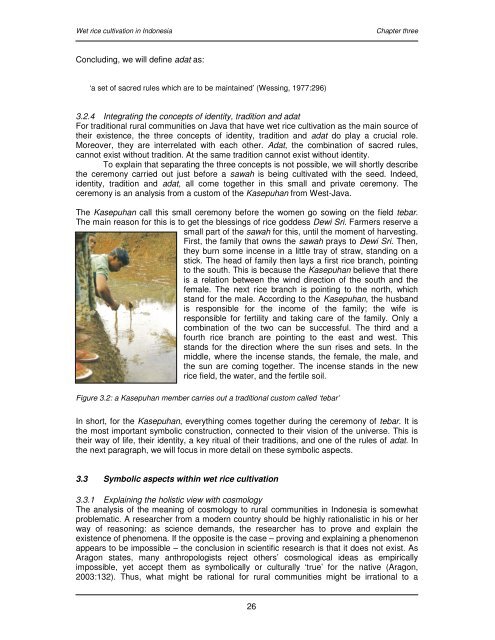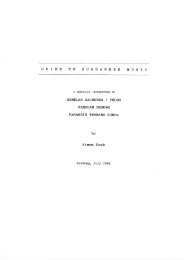Wet rice cultivation in Indonesia - Free EBooks Library
Wet rice cultivation in Indonesia - Free EBooks Library
Wet rice cultivation in Indonesia - Free EBooks Library
You also want an ePaper? Increase the reach of your titles
YUMPU automatically turns print PDFs into web optimized ePapers that Google loves.
<strong>Wet</strong> <strong>rice</strong> <strong>cultivation</strong> <strong>in</strong> <strong>Indonesia</strong> Chapter three<br />
Conclud<strong>in</strong>g, we will def<strong>in</strong>e adat as:<br />
‘a set of sacred rules which are to be ma<strong>in</strong>ta<strong>in</strong>ed’ (Wess<strong>in</strong>g, 1977:296)<br />
3.2.4 Integrat<strong>in</strong>g the concepts of identity, tradition and adat<br />
For traditional rural communities on Java that have wet <strong>rice</strong> <strong>cultivation</strong> as the ma<strong>in</strong> source of<br />
their existence, the three concepts of identity, tradition and adat do play a crucial role.<br />
Moreover, they are <strong>in</strong>terrelated with each other. Adat, the comb<strong>in</strong>ation of sacred rules,<br />
cannot exist without tradition. At the same tradition cannot exist without identity.<br />
To expla<strong>in</strong> that separat<strong>in</strong>g the three concepts is not possible, we will shortly describe<br />
the ceremony carried out just before a sawah is be<strong>in</strong>g cultivated with the seed. Indeed,<br />
identity, tradition and adat, all come together <strong>in</strong> this small and private ceremony. The<br />
ceremony is an analysis from a custom of the Kasepuhan from West-Java.<br />
The Kasepuhan call this small ceremony before the women go sow<strong>in</strong>g on the field tebar.<br />
The ma<strong>in</strong> reason for this is to get the bless<strong>in</strong>gs of <strong>rice</strong> goddess Dewi Sri. Farmers reserve a<br />
small part of the sawah for this, until the moment of harvest<strong>in</strong>g.<br />
First, the family that owns the sawah prays to Dewi Sri. Then,<br />
they burn some <strong>in</strong>cense <strong>in</strong> a little tray of straw, stand<strong>in</strong>g on a<br />
stick. The head of family then lays a first <strong>rice</strong> branch, po<strong>in</strong>t<strong>in</strong>g<br />
to the south. This is because the Kasepuhan believe that there<br />
is a relation between the w<strong>in</strong>d direction of the south and the<br />
female. The next <strong>rice</strong> branch is po<strong>in</strong>t<strong>in</strong>g to the north, which<br />
stand for the male. Accord<strong>in</strong>g to the Kasepuhan, the husband<br />
is responsible for the <strong>in</strong>come of the family; the wife is<br />
responsible for fertility and tak<strong>in</strong>g care of the family. Only a<br />
comb<strong>in</strong>ation of the two can be successful. The third and a<br />
fourth <strong>rice</strong> branch are po<strong>in</strong>t<strong>in</strong>g to the east and west. This<br />
stands for the direction where the sun rises and sets. In the<br />
middle, where the <strong>in</strong>cense stands, the female, the male, and<br />
the sun are com<strong>in</strong>g together. The <strong>in</strong>cense stands <strong>in</strong> the new<br />
<strong>rice</strong> field, the water, and the fertile soil.<br />
Figure 3.2: a Kasepuhan member carries out a traditional custom called ‘tebar’<br />
In short, for the Kasepuhan, everyth<strong>in</strong>g comes together dur<strong>in</strong>g the ceremony of tebar. It is<br />
the most important symbolic construction, connected to their vision of the universe. This is<br />
their way of life, their identity, a key ritual of their traditions, and one of the rules of adat. In<br />
the next paragraph, we will focus <strong>in</strong> more detail on these symbolic aspects.<br />
3.3 Symbolic aspects with<strong>in</strong> wet <strong>rice</strong> <strong>cultivation</strong><br />
3.3.1 Expla<strong>in</strong><strong>in</strong>g the holistic view with cosmology<br />
The analysis of the mean<strong>in</strong>g of cosmology to rural communities <strong>in</strong> <strong>Indonesia</strong> is somewhat<br />
problematic. A researcher from a modern country should be highly rationalistic <strong>in</strong> his or her<br />
way of reason<strong>in</strong>g: as science demands, the researcher has to prove and expla<strong>in</strong> the<br />
existence of phenomena. If the opposite is the case – prov<strong>in</strong>g and expla<strong>in</strong><strong>in</strong>g a phenomenon<br />
appears to be impossible – the conclusion <strong>in</strong> scientific research is that it does not exist. As<br />
Aragon states, many anthropologists reject others’ cosmological ideas as empirically<br />
impossible, yet accept them as symbolically or culturally ‘true’ for the native (Aragon,<br />
2003:132). Thus, what might be rational for rural communities might be irrational to a<br />
26








